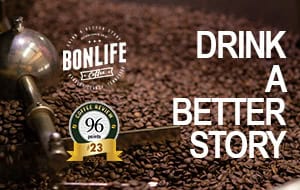Coffee Review readers nominated close to four hundred coffees for potential review over the past year or so. Here are my reviews of nineteen of those nominated coffees. Many of them were quite exciting; all were interesting.
When selecting coffees for review from among those nominated I tried to balance between offerings of large companies that attracted multiple nominations (Starbucks, Caribou Coffee, Gevalia, Dunkin’ Donuts, Allegro Coffee) and coffees from smaller companies whose nominators were fewer but every bit as enthusiastic. Some readers shared their personal evaluations of the coffees they nominated at considerable length; others simply filled in the name of the coffee and roaster and clicked “Submit.”
Three-Tier Implications
It was only after I finished writing the reviews and organizing them by rating that one of the larger implications of this cross-section sampling of American coffees surfaced. I noticed that the reviewed coffees very roughly arranged themselves into three tiers: the highest rated group of coffees almost all were produced by large – though not extremely large – regional roasters. The lowest-rated tier was occupied mainly by generic blends from two extremely large companies – Starbucks and Dunkin’ Donuts – while the mid-tier coffees often were produced by smaller regional roasting companies. There were exceptions to this three-part schema, of course, but overall it applied.
Disturbing Implications
I find this outcome understandable, but a bit disturbing.
Understandable, because the medium-sized companies whose coffees dominated the upper tier of ratings arguably are in the strongest position to source the best green coffee. They can buy coffee in volume directly from coffee producers rather than through domestic dealers on a “spot” basis, as most smaller companies are forced to do. On the other hand, they are not compelled to buy the enormous, quality-dampening quantities of coffee Starbucks and the suppliers to Dunkin’ Donuts are forced to buy. Furthermore, medium-sized companies have sufficient resources to buy the best roasting technology and knowledge, yet don’t need to crank out the endless, largely anonymous rivers of coffee Starbucks and Dunkin’ need to.
Then again, as a coffee idealist I find the implication disturbing that smaller roasting companies do not consistently produce coffees quite as interesting and good as medium-sized companies do. (This is not the first time that this implication has surfaced in the pattern of our ratings, by the way.) There are clear exceptions, of course. The Supreme Bean in Los Angeles has consistently sent us superb coffees, and appears to be quite a small operation.
Rooting for the Underdog – With Reservations
Finally, as a Yankees-resenting Cubs fan I was not disappointed that the mainstream blends from Starbucks and Dunkin’ Donuts landed near the bottom of the standings in this survey. Nevertheless, this outcome also concerns me, given the immense importance of these two giants. After all, they supply the places millions of coffee drinkers all over the world go for their better-than-supermarket coffee experience.
A Threatened Cultural Expression
In particular, the rather spectacularly poor quality of the reviewed sample of the Dunkin’ Donuts Original Blend disturbed me, because Dunkin’ is the leading champion of the bright, medium-roasted traditional American (and Northern European) breakfast cup, a valuable cultural expression currently threatened by Starbucks and its many dark-roasting imitators. Listen, for example, to reader Byron Moe, a Dunkin’ Donuts nominator: “New Englanders can’t seem to operate without a “Regular cup of Joe” and Dunkin’ Donuts seems to be the preferred choice of many a drinker. You cannot go anywhere without running into a store, or someone with a cup in their hands. Give it a look, it is an excellent cup of coffee!”
I gave it a look a couple of years ago, and came away impressed (Dunkin’ Donuts Original Blend, March 2002). I tried it again this month and was depressed by a virtual textbook anthology of taste taints. Hopefully I just hit a bad bag, but I fear a trend toward quantity over quality. America needs some good, bright, acidy medium-roasted coffees like those supplied by Dunkin’. Many coffee drinkers prefer this bracing medium-roast experience to the rounder, sweeter medium-dark roasting styles and the bitter ultra-dark roasts of the specialty folks or the tasteless brown water produced by supermarket canned robusta blends.
Cures for the Starbucks Main-Menu Blues
On the other hand, coffee drinkers should have no problem finding alternatives to the two rather mediocre main-menu Starbucks blends reviewed here. Smaller specialty roasters offer lots of medium-dark to dark-roasted offerings of impressive quality, and Starbucks itself produces some excellent alternatives in its “Commitment to Origin” series. (Look for the special displays of bagged wholebean coffees scattered among the other paraphernalia at Starbucks locations.) Apparently the coffee folks at Starbucks put their passion into these often outstanding limited releases (see, for example, Starbucks Serena Organic Blend, February 2004) but may be tempted to buy by number when faced with the challenge of acquiring the massive volume of coffees that go into the often sad and listless versions of the blends on the main Starbucks menu.
Readers Rule
Finally, the upside of this month’s review. Readers pointed us to still another stunning Kenya AA (95) from Bucks County to go with other fine Kenyas recently reviewed from Intelligentsia and Green Mountain. They also turned up a first-rate Kona (Bayview Farms) and impressive entries from Allegro, Caribou Coffee, and Orleans Coffee Exchange. All in all, eight coffees out of the thirty-plus I cupped generated ratings of 88 or over, indicating that Coffee Review readers do have good taste (or at least similar tastes to mine).
2004 The Coffee Review. All rights reserved.











